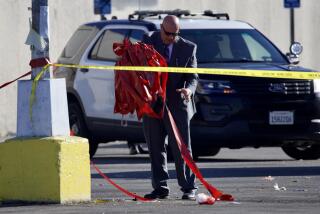Cable Joins Together to Take On Violence : Television: Next week about 50 outlets will respond to congressional pressure by offering messages and programs against violence.
- Share via
Next week on the Weather Channel, you can learn all about how heat, the lack of sunlight and other weather conditions impact societal violence in a series of shorts commissioned by the generally benign cable entity.
Or you can flip over to Prime Sports to learn how sports violence affects players and fans.
Court TV, meanwhile, will devote an hour each night to the discussion of such issues as the federal government’s efforts to deal with the growing rate of violent crime in America.
In fact, no matter which cable channel you turn to next week, chances are you will stumble across anti-violence messages and special programming. At least, that’s the plan. President Clinton even recorded a couple of public-service announcements that will be shown in heavy rotation on the 50 or so cable networks participating in the industrywide Voices Against Violence Week that begins Sunday.
The massive, unprecedented programming effort--roughly half of what will be shown was produced specifically for the campaign--is the cable industry’s way of saying, “We can take care of ourselves.”
When the voices of Congress were rising against television violence in 1993, cable programmers responded by adopting a voluntary initiative. The self-guided measures--from the use of parental advisory labels to participating in a leadership conference on the issue--were designed to stay one step ahead of the lawmakers, who at the time were threatening strict regulation of the broadcast industry.
Voices Against Violence is the cable programmers’ latest measure in demonstrating that the most effective way to reduce violence on television is through private-sector efforts. Rather than trickle out their anti-violence activities, which they say are ongoing, they chose to harness their collective power at once.
“The cable channels together represent a massive force in aggregate. People don’t watch one channel at a time; they watch multiple channels simultaneously and over time,” said Joshua Sapan, chairman of Voices Against Violence and president of Rainbow Programming Holdings Inc.
It was Sapan’s idea to mobilize the cable community to encourage good behavior, since it was getting so much flak for influencing bad behavior. Rainbow’s holdings include Bravo, which will deal with how children portray violence through art in its series “Opening Shot,” and American Movie Classics, which will showcase a week of family films with a prime-time host discussing the importance of nonviolent programming.
“We decided to invite each of the cable channels to participate in a manner akin to their own audience and programming,” Sapan explained.
Among the participating cable networks, at least 1,500 public-service announcements loaded with celebrity support and 130 individual programs will be shown. More than a dozen national organizations, from the American Medical Assn. to the National Council of Churches, have joined in to publicize the campaign with their constituents.
Each channel is choosing its own tact--from education to entertainment. Showtime’s heavy schedule of documentaries and special series episodes, for example, includes the Sunday premiere of the original film “Zooman,” starring Louis Gossett Jr., as a man searching for justice following the murder of his daughter (see review, page F16).
In a special report for the children’s cable network Nickelodeon, Linda Ellerbee found that the scariest thing on television for children was the news.
“When we asked why, they said because it’s real,” said Ellerbee, who produced the half-hour “Are You What You Watch?” “When we questioned them further, they said local news was more scary than national news because it’s closer to home. The scariest story was when a child was hurt or killed. Over and over, they weren’t sure whether watching violence makes you violent, but they said watching violence makes you scared.”
Bill Curtis, a news anchor for the CBS station in Chicago, agrees that TV news contains too many sensational and violent images. But he denied the suggestion that the cable industry’s weeklong effort is just a big public-relations campaign to gloss over the real issue.
“I’m sure there will be a lot of violence forever on broadcast and cable television,” said Curtis, who executive-produced special anti-violence episodes of “Investigative Reports” and “American Justice” for A&E.; “I’m glad to see that we are at least responding and asking the question: Are we creating a culture of violence?”
The themed cable week will deal both with violence on television and the escalating problem of violence in society. Congress has been trying to prove a cause-and-effect relationship between the two ever since Sen. Paul Simon (D-Ill.) began crusading against TV violence on Capitol Hill.
“Three years ago, you would have gotten the majority of the industry to say it’s not our problem. How dare they point the finger at us?” said Tony Cox, who spearheaded the cable industry’s anti-violence initiative in August, 1993, and who until he resigned this week had been senior vice president of Viacom Inc.
“I’ve been presented with research that suggests television has minimal effect on violence in this country, but it has some,” Cox said. “Even if you only have some, you have some responsibility to respond. That’s where the cable industry really is.”
If Voices Against Violence works, cable programmers expect to coordinate similar efforts in the future. The challenge will come in assessing the campaign’s success.
“To my mind, the goal is to actually alter violent behavior incrementally, both in society and how it’s portrayed on television,” Sapan said. “TV is potent, and it will have an effect. But it will be difficult to measure whether five or 10 lives are ultimately saved, or a bunch of kids simply think before they act.”
Cable violence will most likely return to normal levels after the week ends. But Cox points out that change is ongoing. Executives meet regularly with producers and writers, both in private and in public panels, to work toward deglamorizing violence on TV the way that drinking, drug use and cigarette smoking have been. In addition, the cable industry supports a ratings system and the use of a “viewer-discretion technology” to block out violent programs.
Most significantly, two independent monitoring services were established at Simon’s strong urging last year--one for cable and one for broadcast--to assess and analyze TV violence. They will issue their “report cards” later this year.
“What we’d really like is for somebody to acknowledge that violence in society isn’t our fault,” Cox said. “Maybe there are other things causing (societal) violence--handguns and drugs, all these things politicians are gutless to do anything about. I’m suggesting that television has been scapegoated by politicians unwilling or unable to address the real causes of violence.”
More to Read
The complete guide to home viewing
Get Screen Gab for everything about the TV shows and streaming movies everyone’s talking about.
You may occasionally receive promotional content from the Los Angeles Times.






